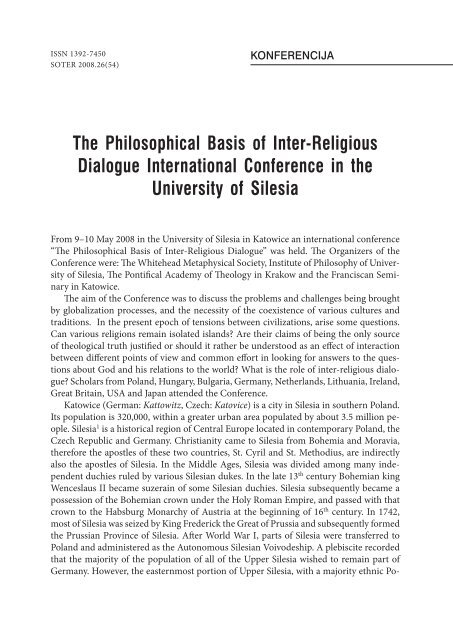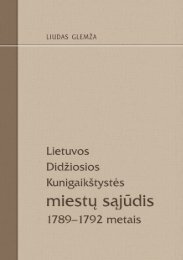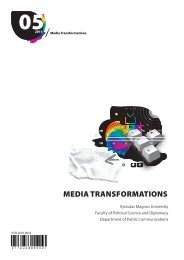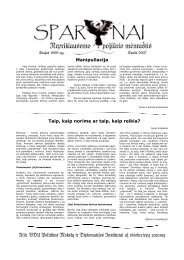Soter Nr. 26 - Vytauto Didžiojo universitetas
Soter Nr. 26 - Vytauto Didžiojo universitetas
Soter Nr. 26 - Vytauto Didžiojo universitetas
You also want an ePaper? Increase the reach of your titles
YUMPU automatically turns print PDFs into web optimized ePapers that Google loves.
ISSN 1392-7450<br />
SOTER 2008.<strong>26</strong>(54)<br />
KONFERENCIJA<br />
The Philosophical Basis of Inter-Religious<br />
Dialogue International Conference in the<br />
University of Silesia<br />
From 9–10 May 2008 in the University of Silesia in Katowice an international conference<br />
“The Philosophical Basis of Inter-Religious Dialogue” was held. The Organizers of the<br />
Conference were: The Whitehead Metaphysical Society, Institute of Philosophy of University<br />
of Silesia, The Pontifical Academy of Theology in Krakow and the Franciscan Seminary<br />
in Katowice.<br />
The aim of the Conference was to discuss the problems and challenges being brought<br />
by globalization processes, and the necessity of the coexistence of various cultures and<br />
traditions. In the present epoch of tensions between civilizations, arise some questions.<br />
Can various religions remain isolated islands? Are their claims of being the only source<br />
of theological truth justified or should it rather be understood as an effect of interaction<br />
between different points of view and common effort in looking for answers to the questions<br />
about God and his relations to the world? What is the role of inter-religious dialogue?<br />
Scholars from Poland, Hungary, Bulgaria, Germany, Netherlands, Lithuania, Ireland,<br />
Great Britain, USA and Japan attended the Conference.<br />
Katowice (German: Kattowitz, Czech: Katovice) is a city in Silesia in southern Poland.<br />
Its population is 320,000, within a greater urban area populated by about 3.5 million people.<br />
Silesia 1 is a historical region of Central Europe located in contemporary Poland, the<br />
Czech Republic and Germany. Christianity came to Silesia from Bohemia and Moravia,<br />
therefore the apostles of these two countries, St. Cyril and St. Methodius, are indirectly<br />
also the apostles of Silesia. In the Middle Ages, Silesia was divided among many independent<br />
duchies ruled by various Silesian dukes. In the late 13 th century Bohemian king<br />
Wenceslaus II became suzerain of some Silesian duchies. Silesia subsequently became a<br />
possession of the Bohemian crown under the Holy Roman Empire, and passed with that<br />
crown to the Habsburg Monarchy of Austria at the beginning of 16 th century. In 1742,<br />
most of Silesia was seized by King Frederick the Great of Prussia and subsequently formed<br />
the Prussian Province of Silesia. After World War I, parts of Silesia were transferred to<br />
Poland and administered as the Autonomous Silesian Voivodeship. A plebiscite recorded<br />
that the majority of the population of all of the Upper Silesia wished to remain part of<br />
Germany. However, the easternmost portion of Upper Silesia, with a majority ethnic Po-





